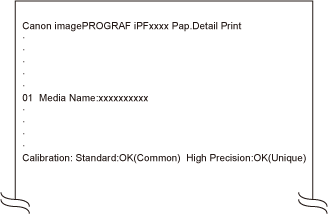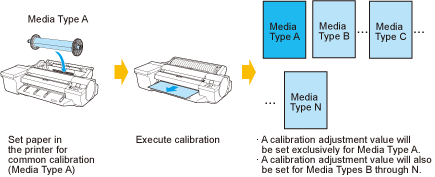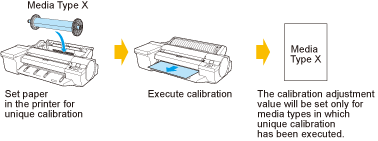|
|
Color Calibration - Recommended Environment for Use of Paper
| Article ID: ART136261 |
| |
Date published: 05/13/2015 |
| |
Date last updated: 10/30/2015 |
Description
Since the recommended use environment varies according to the paper type, use within the recommended environment range suiting the paper type.
Solution
| | Recommended Environment for Use of Paper |
Since the recommended use environment varies according to the paper type, use within the recommended environment range suiting the paper type. | Paper Type and Adjustment Type |
- The paper types that can be used for color calibration differ between the case of executing using the printer sensor (Auto Adjust) and the case of executing using the optional Spectrophotometer Unit (AutoAdjst(HiPrc)).
- When color calibration is executed using the printer sensor, the color calibration adjustment type is predetermined.
- When color calibration is executed using the Spectrophotometer Unit, Unique calibration is executed.
- The media types shown in the table are the names that are displayed in the printer Control Panel.
 | Note | • If the paper you are using is not specified in media type, execute color calibration using the paper where the adjustment type is Common calibration, then you can set the calibration adjustment values for the paper you are using.
• The settings for each media type can be changed using Media Configuration Tool. Not available media types can be displayed in the Control Panel by changing the settings. |
| Paper Sizes that can be Used in Color Calibration |
Paper sizes that can be used in color calibration differ for sheets and rolls.
•When executing Auto Adjust by the Printer Sensor
•When executing AutoAdjst(HiPrc) Using the Spectrophotometer Unit
Roll paper at least 406.4 mm (16.00 in) wide | Registration and Confirmation of Paper Information |
•To Register Paper Information on the Printer - When using newly released paper, paper information must be registered on the printer and the printer driver. Download the new version of Media Information File from the Canon website and install it.
- Use the Media Configuration Tool to add information for media other than genuine Canon paper or media for purposes other than checking output to the printer and the printer driver.
•To Confirm the Paper Information Registered on the Printer - Refer to the Calibration sheet on the Color Calibration Management Console when checking details on the computer.
- To print media information, select Paper Details on the Control Panel menu. The following is displayed in the Calibration field.
 | Important | To restore the default settings, set Reset PaprSetngs to Yes in System Setup in the Control Panel menu. Because paper information added or modified by the Media Configuration Tool is deleted, if you have calibrated the printer using paper with information added by the Media Configuration Tool, color calibration executed this way can no longer be applied to any type of paper.
If you wish to apply calibration results, prepare calibration-compatible paper that was in the original settings and perform calibration again. |
| Adjustment Types of Color Calibration |
Color calibration has two adjustment types, Common calibration and Unique calibration, with one of these selected when color calibration is executed.
The selected adjustment type is determined from the media type that color calibration is executed on.
•Common calibration
Common calibration is a feature that allows you to use multiple media types easily in a short time because it is not necessary to execute color calibration on each media type.
If color calibration is executed on paper categorized as Common calibration, dedicated calibration adjustment values are set on the media type that Common calibration was executed on.
Furthermore, calibration adjustment values are set on all print qualities for all media types where color calibration has not been executed.  | Note | • The calibration adjustment values are not overwritten for media types where color calibration has been executed once and dedicated calibration adjustment values have been set.
 |
•Unique calibration
If color calibration is executed on paper categorized as Unique calibration, calibration adjustment values are set only for the media type that the color calibration was executed on.  | Note | • Even if paper categorized as Unique calibration is used, if the media type has yet to execute color calibration even once and does not have any dedicated calibration adjustment values, the calibration adjustment values are overwritten when Common calibration is executed.
• Calibration values configured by color calibration using the printer sensor and calibration values configured by color calibration using the optional Spectrophotometer Unit are managed as separate data. Because of this, the calibration values configured using the Spectrophotometer Unit are not overwritten when Common calibration is executed using the printer sensor. |
| Checking the Applied Calibration Values |
Depending on the paper type, it may be possible to execute color calibration using the printer sensor and the Spectrophotometer Unit and to have two sets of calibration values.
In this case, the calibration values that were set when color calibration was executed the last time are applied when printing.
The currently applied calibration values can be checked using the Color Calibration Management Console or Control Panel menu.
|
|




